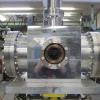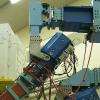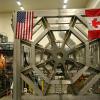A major experimental capability at Bates, especially during the last years of its operation as a National User Facility for Nuclear Physics, was the Bates Large Acceptance Spectrometer Toroid (BLAST). BLAST was designed to use the storage ring capability of the South Hall Ring along with internal gas targets, including polarized targets. The scientific program provided insight not only into the subatomic scale but also into the astronomic scale. It addressed issues of central importance to intermediate energy nuclear physics: the structure of the nucleon; the spin structure of the weakl
Completed Projects
Historically, electron scattering from nucleons and nuclei was used to measure the size and the electric and magnetic properties of the nucleons and nuclei. It was always assumed that the scattering was mediated by the exchange of a single photon. Then, in 2000, measurements at JLab showed a significant discrepancy in the ratio of the electric to magnetic form factor of the proton as measured using the traditional, unpolarized technique and new measurements using polarized techniques. The most likely explanation for the discrepancy was that two-photon exchange had a significant role in e
Another major and pioneering experimental effort at Bates involved the Out-Of-Plane Spectrometer (OOPS). OOPS was a special version of coincidence measurements with magnetic spectrometers. Prior to OOPS coincidence events from electron scattering were carried out with both spectrometers supported in the horizontal plane. This was the case because the problem of detecting one of the particles in an arbitrary direction required a more complicated support system for the spectrometers. The OOPS Collaboration decided that the additional important information that one could gain made the chal
An international collaboration of scientists working at Jefferson Lab has completed a new precision measurement of parity-violating electron scattering on the proton at very low Q2 and forward angles to challenge predictions of the Standard Model and search for new physics.
Measurement of the Singlet Anomalous Magnetic Moment of the Proton using Parity Violating Elastic Electron Scattering





